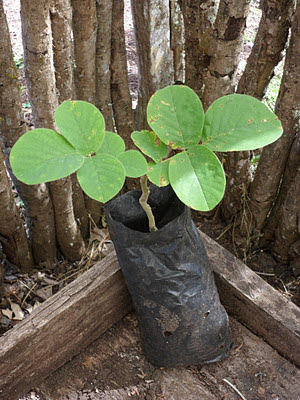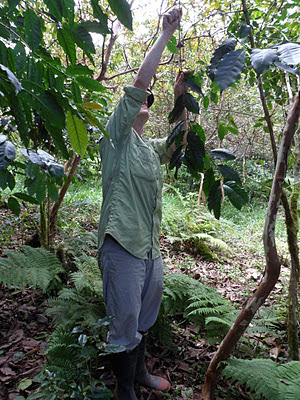For those who have lived and worked at the Hacienda, climbing up the steep Sendero al Mirador brings you to an indescribable view of the ocean and Leon Dormido. If you’ve been there recently, you most likely have seen the new 6000 square meter area that has been cleared of invasive species by our hardworking volunteers. In it, you will find several endemic species to the Galapagos, as well as other species that are critical to the unique structure of the islands. Volunteers continue to help maintain the area and plant new species when needed. With this effort, the Hacienda and those that work for our cause help to restore the delicate ecosystem to its original condition.

This week's post includes a few of the species that can be found in various places around the Hacienda. Many of these species are considered endangered because of the threat of invasive species on the island. What we focus on, however, is restoring these plants and then carefully cultivating their growth. Our efforts have significantly increased their survival by limiting the threat of invasive species.
Here's a brief explanation of some of the species:
Matazarno
I am a flowering plant endemic to the Galapagos that can reach up to 15 meters high with a grayish bark, shiny green leaves, and small green or greenish-yellow fruit, similar in appearance to an apple. Many refer to me as the “poison apple tree” because my parts contain strong toxins and the fruit can be fatal if eaten. Yet, I am unique because I capture a vast amount of carbon dioxide, with one plant capturing 470 kilograms per year.
Manzanilla
I am a flowering plant endemic to San Cristobal and Santa Cruz islands. I am a shrub or small tree that can grow to 15 meters and have white to pink or purple flowers. My extremely hard inner wood is used for constructing houses and boats in the archipelago. I capture a large amount of carbon dioxide from the atmosphere, specifically 148 kilograms per year.
Lecocarpus Darwinii
I am one of seven angiosperm genera restricted solely to the Galapagos Islands. Yet, I am the least likely to be seen by tourists because I am not present at the popular visitor sites. I am considered to be an endangered species, and my restoration to the island is vital. I can grow to 1.5 meters tall and have numerous branches with a single stem at the base. My leaves are opposite at 3-10 cm in length, contain yellow flowers near my branch tips, and have fruit with one or more curved spines of variable length.
Scalesia
I grow as a shrub or tree that contains soft wood and gummy sap, and my young branches are usually hairy. My leaves are usually crowded near the branch tips, and dried remnants of the previous year’s growth persist beneath. I am not as well represented on San Cristobal or Santiago as I have in the past. It appears to be the result of damage caused by goats and pigs that were allowed to freely roam, and demonstrates the danger of introducing alien species to the archipelago.
For those interested in exotic plant species from around the world, Hacienda Tranquila is the perfect environment to experience species found in the Galapagos Islands. So come and learn in a special and unique place. We hope to see you soon!
Cheers,
Hacienda Tranquila



























